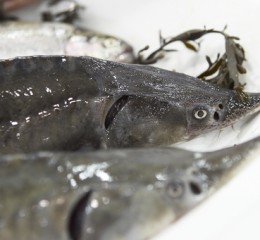


A matter for specialists.
Explaining how to make caviar is simple … and, at the same time, utterly impossible. Simple because those few steps seem open to anyone to do. Impossible because, in reality, what has to be done requires experience of, and knowledge about, sturgeons' subtle and unique eggs.
The female sturgeon is immediately bled after being caught so as to avoid any contamination of the grains of caviar. The ovaries are then taken out in a sterile environment and plunged in very cold (close to 0°C) brine (30% salt). The pieces are then sieved through mesh so as to isolate the eggs and eliminate any impurities. The eggs are put back put in brine – however, this time it's much less salty – drained and (finally) vacuum-packed in either glass pots or metal tins ... and covered with a varnish to prevent the grains becoming oxydised. The caviar has now been prepared!
Sturgeon's eggs are particularly fragile. Too much salt and they become hard and opaque. Not enough and they get crushed under their own weight. All these operations must be performed in a temperature of less than 10°C. It's the low temperature that will, for the most part, be the main preserving agent, even more than the salt. Caviar can also be pasteurised at a relatively low temperature (less than 60°C). All caviars sold in Japan are pasteurised, although purists believe that this alters the eggs substantially. Caviar can be kept for up a year in its packaging. It is at its peak in the 3 months immediately following its preparation.
In its metallic tin the caviar is air-tight. The top must be concave; if it is convex (bulging) it means that air has entered and the quality of the contents of the tin can have altered. In such case, it would be best not to eat the caviar and to contact the retailer.